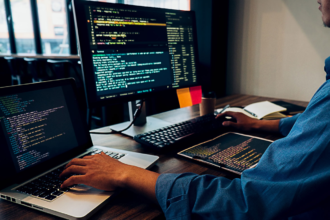Introduction
WhatsApp remains a popular messaging app for kids and pre-teens globally. Recent data show that over 2 billion people use WhatsApp daily, including many children and teens. This rising tendency is convenient but raises worries since the digital world has hidden risks. WhatsApp is used by teens to talk, exchange material, and join online groups. This activity may appear innocent, but it may expose kids to cyberbullying, unsuitable information, and internet predators.
WhatsApp monitoring and parental control applications let parents monitor their children’s internet activity. As internet safety concerns rise, parents must understand WhatsApp risks and how to handle them. Parents may protect their children without compromising privacy by monitoring WhatsApp activity with parental control software. This post explains these hazards and presents ethical WhatsApp tracking apps and practices. Read on to discover the top WhatsApp safety tips for kids.
Part 1. Common Online Threats on WhatsApp for Children
WhatsApp and other chat apps may hide threats for kids. Understanding these hazards is the first step for parents to protect their kids online. Here are several WhatsApp risks for children:
- Cyberbullying:
Cyberbullying is one of the most common difficulties on WhatsApp. Children might be bullied via group conversations or direct messaging. Often, group conversations allow bullies to attack people without immediate repercussions. If parents don’t monitor their child’s WhatsApp, harassment may go unchecked, causing mental tension and worry.
- Online Predators:
Internet predators target minors via WhatsApp. They may masquerade as nice classmates to develop trust and trick kids into revealing sensitive information. They may organize in-person meetings, endangering youngsters. These approaches may accidentally harm children without parental supervision.
- Inappropriate Content:
WhatsApp makes sharing photographs, videos, and links easy. Not all shared material is kid-friendly. Explicit or hazardous material may injure and disturb them. They may avoid such content by monitoring their activity.
- Addiction and Overuse:
Messaging applications may keep kids hooked. Their academic performance, sleep, and well-being may suffer from online hours. Without supervision, youngsters may acquire dangerous screen habits that are hard to stop.
Understanding these threats emphasizes the need for proactive parental control and WhatsApp monitoring software.
Part 2. What Can Parents Do? Best Parental Control Tool for WhatsApp Monitoring
Parents worry about their children’s WhatsApp safety, particularly with online threats. Fortunately, parents can take numerous actions to keep their kids safe. WhatsApp’s privacy settings may be used to track and manage behavior. These features let parents block hazardous information and unwelcome interactions. Here is a summary of how parents may utilize these settings:
- Best WhatsApp Monitoring App for WhatsApp – WaLastseen
WhatsApp’s built-in privacy settings may not be adequate to protect your youngster. Parents may utilize WaLastseen for more complete monitoring. This unique tool is used to monitor WhatsApp activity and gives parents precise information about their child’s use. WaLastseen lets you monitor online times, conversations, and message patterns without being obtrusive.
Key WaLastseen Features
WaLastseen has various useful features that make it an excellent solution for parents who want to monitor their child’s WhatsApp activity as follow quietly:
- Track Online/Offline Status: Track users’ online and offline statuses to measure active times.
- Detailed Usage Reports: Receive thorough reports, including daily and weekly WhatsApp summaries.
- Track multiple Contacts: Manage your children’s accounts more easily by tracking numerous contacts.
- Continuous Activity Tracking: Never miss important actions with 24/7 monitoring.
- Non-Intrusive Monitoring: The app discreetly tracks users without alarm.
- Anonymous Tracking: Keep the watched person unaware of your presence.
WaLastseen’s WhatsApp monitoring for parents’ setup and usage steps are explained here:
Step 1. Install WaLastseen from the Play Store. Launch the app and hit “Add Contacts” after installation. Allowing the app access to your contact list lets it add contacts for monitoring.
Step 2. Once you give permission, the app will import your contacts. Select the ones to monitor by hitting “Add.” Click the “+ Add New” option to provide a nickname and phone number to manually add a contact without sharing your contact list. Then select “Start Tracking.”
Step 3. Tracking requires linking the contact’s WhatsApp. Select “Link-WhatsApp” next to the contact and follow the instructions to authorize access. This stage lets you track internet activity and status.
Step 4. Select a media folder after authorization. Select the folder and hit “Use This Folder.” Enter the country code and monitor the person’s phone number. To connect, input the SMS verification code.
Step 5. If necessary, log in to WhatsApp after inputting the verification code. If you have trouble connecting, retry connecting by choosing “Link-WhatsApp” from the app’s main interface.
Step 6. On “My Profile,” choose “Notification Settings.” Set up real-time online and offline status alerts. This function sends quick notifications when the monitored contact logs in or out.
Step 7. Selecting a contact’s name in the app displays detailed information. The “Activity” area displays online activity charts and graphs. Track the contact’s daily activities using the “Timeline” feature’s accurate timestamps of when they were online or offline.
Step 8. You may track several contacts using WaLastseen. Use “Compare” to see overlapping online hours and determine whether two contacts interact often. You may easily switch contacts to view logs and statuses on the app’s main screen.
Use WaLastseen to monitor your child’s WhatsApp activity and identify hazards without invading their privacy.
- Built-in WhatsApp Privacy Settings
WhatsApp has privacy options that parents can use to keep their kids secure. This controls who may engage with the kid, what can be exchanged, and how much information is displayed. Key privacy characteristics are below:
- Block Unwanted Contacts: Parents may block unwanted contacts from messaging or calling their kids.
- Report Safety and Security Issues: WhatsApp takes action against harassers and harmful material.
- Turn Off Visible Information: To prevent others from seeing the child’s profile photo, status updates, and other personal information, turn off these features.
- Turn Off Live Location on WhatsApp: Parents may deactivate the live location function to ensure their child’s whereabouts are not broadcast unintentionally.
- Turn Off Last Seen on WhatsApp: Disabling “Last Seen” conceals when a kid last used the app, preserving their privacy.
- Turn off WhatsApp Save Images: Disabling automatic picture downloads reduces the risk of improper information reaching youngsters.
- Prevent Being Added to Random Group Conversations: Change the settings so that only contacts may add the kid to group conversations, lowering the chance of exposure to strangers.
These built-in options allow parents to easily manage their child’s WhatsApp use, reducing hazards and making the internet safer.
Part 3. Best Practices for Keeping Kids Safe on WhatsApp
Parents must be proactive and supportive to keep kids safe on WhatsApp. A WhatsApp monitoring app like WaLastseen can assist with internet security but requires communication, education, and consistency. These ways may help parents protect their children:
- Open Communication
Openly discuss WhatsApp and other online platform concerns with your kids. Explain that you are monitoring their activities to protect them from danger and not to violate their privacy.
- Teach Children About Privacy Settings
Your child needs help setting up and using WhatsApp’s privacy settings. Explain why they should restrict their profile image, status updates, and last seen status. These little efforts may greatly improve safety.
- Monitor Screen Time
Overusing messaging applications may expose users to internet risks and distract them from normal tasks. Limit WhatsApp time to help your child balance online and offline activities.
- Encourage Safe Online Behavior.
Children should never tell strangers their whereabouts, school, or phone number. Encourage children to avoid talking to strangers and explain the risks of disclosing personal information.
- Check WhatsApp Chat Regularly.
You should regularly check your child’s chats and group messages for improper material and unsafe interactions. Make this a habit and urge your youngster to tell you anything strange.
Conclusion
To protect children from overexposure, parents must limit WhatsApp use. With cyberbullying, internet predators, and improper information on the rise, parents must be educated and vigilant. WaLastseen helps parents watch their child’s behavior without compromising their privacy, making it simpler to spot and manage dangers.
Best practices, including open communication, privacy settings, monitoring screen time, and promoting safe online behavior help parents keep their kids safe. These tools and ideas help parents balance their children’s autonomy and safety. Parental control should encourage trust and open communication to help kids navigate the digital world. The correct tools and parenting style may help youngsters be safe online without feeling overwatched.












